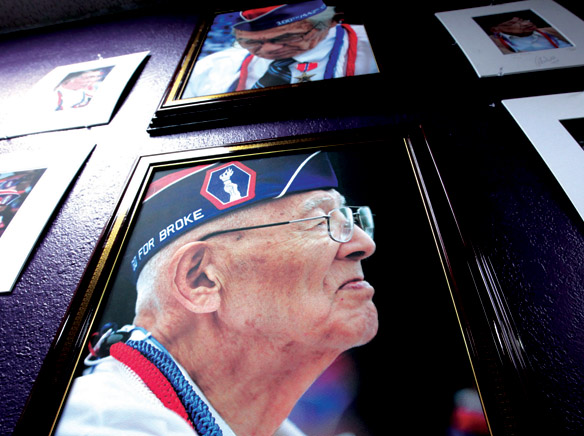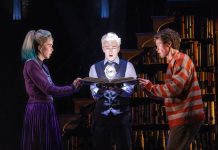Faces of Japanese American WW II Veterans, some looking stoic and others emotional, line the interior walls of Toyo Photography in Gardena, where they will soon be on display as part of the Go for Broke World War II Veterans photography exhibit.
Faces of Japanese American WW II Veterans, some looking stoic and others emotional, line the interior walls of Toyo Photography in Gardena, where they will soon be on display as part of the Go for Broke World War II Veterans photography exhibit.
Photographer Gary Miyatake, grandson of well-known photographer Toyo Miyatake, took the veterans' portraits during the June 9 Los Angeles Regional Congressional Gold Medal Celebration.
The celebration was held in honor of the all-Japanese-American veterans of the U.S. Army's 100th Infantry Battalion, Military Intelligence Service (MIS) and 442nd Regimental Combat Team, also known as the Go for Broke Veterans, who were all awarded the Congressional Gold Medal.
The medal, the highest civilian award the country can bestow, was awarded by Congress Oct. 5, 2010, for the veterans' outstanding service during WW II.
Miyatake said his exhibit slated for Dec. 8 at his Gardena Boulevard studio in Gardena, will consist of between 60 to 70 portraits. Some of the photos are signed by veterans and Rep. Adam Schiff, D-Calif., who was the main sponsor of the legislation awarding the medal.
The exhibit was meant to capture a moment in history and raise public awareness of the Go for Broke Veterans' contribution to the WW II, he said.
“These guys are not written up in history,” Miyatake said. “When they (history books) talk about the soldiers and people in World War Two they don't talk about these Go for Broke Veterans; the Four-Four-Two, the MIS, the Hundredth Battalion. You can go into any bookstore or any library; there's nothing.”
Miyatake said the photographs are significant because these veterans are nearing the end of their lives, some have already passed away since the Gold Medal Celebration, and his portraits may be the last taken of many of them.
Don Nose, president of the Go For Broke National Education Center (GFBNEC), expressed a similar sentiment.
“These individual portraits are capturing a quickly fading and very important part of history,” Nose said.
Miyatake said he will be selling the portraits from between $100 to $1,000, the higher price range being attached to photographs signed by both the veteran in the portrait and Schiff.
He said that the exhibit is not associated with GFBNEC, but he would be willing to donate up to 50 percent of his profits to the Education Center although he had not worked out the details yet. Nose also said that no arrangement for a donation amount had been made.
“If we were to be the beneficiaries of a generous donation from him (Miyatake) as a result of his photos we would be very happy to receive it,” Nose said.
The GFBNEC's main purpose is documenting the history of individual members of the Go For Broke Veterans group and educating the public about their important contribution to WW II and the Japanese American community, Nose said.
He said that despite discrimination and being sent to internment camps, many Japanese Americans volunteered for military service once they were allowed to, while others were drafted straight out of the internment camps. Both groups served with equal dedication.
“They all had this essence that they wanted to prove their country wrong for discriminating against them,” Nose said. “That was the unifying thing that I think drove them to their military success.”
He said this success included being the most highly decorated units, in relation to their size, in the military history of the United States, with over 9,000 Purple Hearts, 4,000 Bronze Stars and 21 Medals of Honor being awarded to unit members.
The awarding of the Congressional Gold Medal to the Go For Broke Veterans in 2010 was an important moment for them and more than 150 veterans traveled from around the country to attend the 2012 Gold Medal Celebration in Los Angeles, Nose said.
Two of the veterans present were, Jack Kunitomi, 97, and Don Oka, 92, who both served in the MIS and will both have their portraits displayed in Miyatake's photo exhibit.
Kunitomi spent time in the Manzanar Internment Camp before being drafted into the Army and sent to a military language school.
After completing his training he was transferred to the MIS where he served as a translator.
Kunitomi said he felt honored to be awarded the Congressional Gold Medal.
“I think most of us (MIS veterans) gladly took it and were glad to be honored along with the rest of the boys (Go For Broke Veterans),” he said.
Oka said he was drafted into the service just six days before many of his fellow Japanese Americans were sent to internment camps.
He said he was relegated to washing dishes and preparing training areas for other soldiers for over a year before being selected for language school and joining the MIS.
Initially Oka was disgruntled by the double standard of the government towards Japanese Americans but after meeting a group of recruits who had volunteered straight out of internment camps he gained a new perspective, he said.
“That really impressed me,” Oka said. “ I thought 'if these young kids can do this I should be able to stand it.'”
Oka said that, like Kunitomi, he was also appreciative of the Congressional Gold Medal although he was a little put out that the government charged each veteran $50 for an actual medal.
“I think what they gave us was more than enough and I'm honored and proud,” he said.
Both Kunitomi and Oka said they were happy to have their portraits displayed as part of Miyatake's exhibit.
“Its another pat on the back for us,” Kunitomi said.
Another person who said he supports the exhibit and the Japanese-American community is Hussam Ayloush, executive director of the Counsel on American-Islamic Relations.
“The least we can do is support (Japanese American) exhibits because we as a country have done injustice to this great community that has contributed so much to America, including the war efforts against imperialist Japan and Germany,” Ayloush said.
He said that after the 9/11 attacks the Japanese-American community reached out to the American Muslim community to show its support as discrimination against Muslims in the U.S. started to rise and since than, the two communities have become even closer and will continue to support each other in the future.
“It (the Japanese-American community) is a very humble and modest community,” Ayloush said. “It is not asking for recognition and it doesn't know how to brag about the great contributions and achievements that it has made.”
Nose echoed that thought in relation to the Go for Broke Veterans.
“They're not the type of people out to get personnel accolades and they don't tend to be people who say 'Hey look at us; look at the great things we did.'” Nose said. “Most of them never even told their families about what they experienced during the war or what their role was or told any war stories. They just said 'It's part of what we had to do and part of our duty.'”
The Go For Broke WWII Veterans Photography Exhibit will open on Dec. 8 with a reception at Toyo Photography from 5 to 7 p.m. and continue through Dec. 29. People interested in viewing the exhibit can call 310-678-9401 or 310-324-8941 for daily display hours.
Toyo Photography is located at 1305 W. Gardena Blvd., Gardena.



















